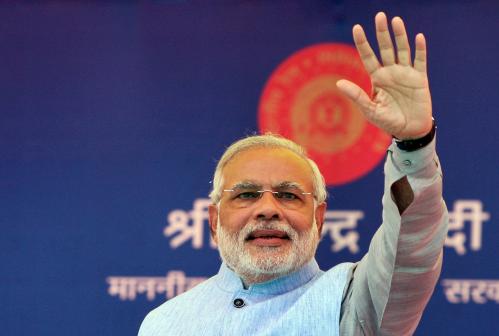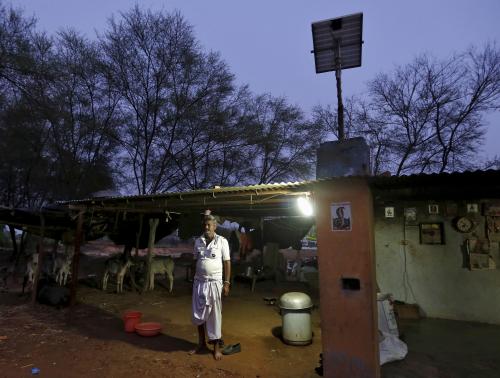Content from the Brookings Institution India Center is now archived. After seven years of an impactful partnership, as of September 11, 2020, Brookings India is now the Centre for Social and Economic Progress, an independent public policy institution based in India.
In this India-U.S. Policy Memo, William Antholis writes that Indian Prime Minister Narendra Modi can move India to the front ranks of international leadership on climate change while also advancing its economic development. He notes that cooperation with the U.S. can help him in that effort.
With less than 18 months to the next major climate change negotiation in Paris in 2015, Prime Minister Modi has an opportunity to move India into the front-ranks of international leadership on the topic. He can do so in a way that is consistent with advancing India’s economic development. Cooperation with the U.S. can help him in that effort.
India’s energy needs and shifting consensus: Affordable and reliable energy remains a high priority for the Modi government, without which growth will continue to be sluggish. Simultaneously, the government recognizes that an exclusive focus on fossil fuels would exacerbate local air pollution and further threaten India’s climate security.
As the world’s fourth largest greenhouse gas emitter, India must be part of any solution to the climate crisis. But since global climate change has many causes—particularly the very large current and historic contributions of developed nations—Indian officials have been reluctant to take a leadership role, particularly in global climate diplomacy with advanced economies. India has followed a principle of Common But Differentiated Responsibilities (CBDR), by which India would only commit to emissions cuts when others reach India’s low per capita emissions level.
Concerns about equity are indeed valid. Still, the consensus within India has begun to shift toward a more activist position in both addressing the causes of climate change, and also preparing for a warmer climate. Thought leaders recognize that climate change affects India directly, through rising sea levels, declining monsoon rainfalls, unpredictable Himalayan melts, etc. Moreover, other large emitters have started to slash emissions. The United States and China have each taken promising steps recently. Given India’s desire to play a leadership role in global bodies, India can benefit from taking a more forward-leaning position prior to the Paris talks.
Cooperating on domestic programs: Prime Minister Modi comes to New Delhi directly from having served as a chief minister. He also comes deeply aware of energy and climate change policy. That preparation will be valuable not only in governing India, but also in partnering with the United States.
Central to Prime Minister Modi’s success in Gujarat was his reform of the state’s energy system—eliminating subsidies and thereby increasing electricity production and distribution. He also became well versed in both the science of climate change, and efforts to slow greenhouse gas emissions. As a result, he prioritized solar power, and self-published a book on his “convenient actions.” That said, there remain some questions about how much Gujarat followed through on ambitious goals, and Prime Minister Modi should try to address those questions in his first months in office.
One opportunity for Prime Minister Modi may be to use his experience as a state-level leader and to apply internally to India the principle of Common But Differentiated Responsibilities. What should be “common” is the obligation for each state to act. What should be different is the level of responsibility. The U.S. Environmental Protection Agency has adopted this approach in designing carbon reduction targets for states, as has the European Union when allocating reduction targets across its member states, and as has China when designing its regional pilot programs. India can share best practices with the United States and the other major, complex, federal and provincial governments.
India and the U.S.: similar views on sovereignty: Once Prime Minister Modi has established a domestic plan of action, he will be empowered to shine globally. This fits with his vision of India as a world power—not looking to others to define India’s greatness, but open to pragmatic cooperation.
Starting with domestic actions will allow the Indian government to avoid concerns that it has sacrificed Indian sovereignty. Just as in the United States, many in India fear that the U.N. process will lead to a global body that will set emissions targets. Instead, India and the U.S. share an interest in ensuring that targets develop from the bottom up—as they should. The U.S. guards its sovereignty as vigilantly as India does. The U.N. process should not dictate obligations.
U.S. must demonstrate that it can act: As the U.S. and India work together, U.S. officials must demonstrate that they feel an obligation to act ambitiously to cut greenhouse gas emissions, given America’s level of economic development and the current size and historic volume of U.S. emissions. In advance of the 2015 climate talks in Paris, the U.S. must keep India abreast about progress on America’s climate program—both building confidence and sharing best practices. The U.S. must also demonstrate that it understands the needs of developing countries—in growing their economies, in improving their resilience to a changing environment, and in slowing their own emissions.
Other areas for cooperation: The U.S. and India can also scope out areas of cooperation, including concrete initiatives: advancing the Green Climate Fund; providing technical help on shale gas exploration; cooperating on solar, wind, and hydro-power technologies; cooperating on forests policy, especially conservation and accounting; cooperating on climate resilience (drought, flood and coastal issues); and developing state-to-state and city-to-city cooperation on resilience, mitigation, monitoring and assessment (e.g. Gujarat-to-California; Mumbai-to-New York).










